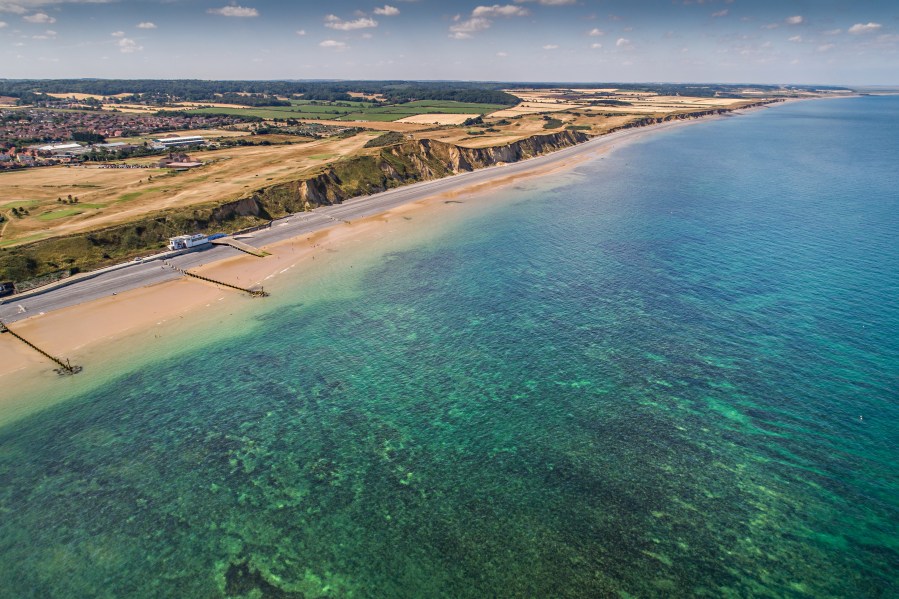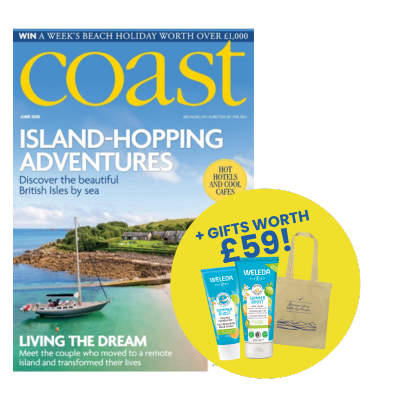Liz Hollis travels to Norfolk and Suffolk coast to explore what this impressive coastline has to offer, sharing where to visit, stay and eat!
Stretching 140 miles between The Wash and the estuaries of the rivers Orwell and Stour, the coastline of Norfolk and Suffolk has some unique and unexpected attractions.
With every justification it has become one of the most-visited coastal regions in the UK with its enviable list of holiday resorts and beaches to explore. Top of the tourist list are the coastal towns of Cromer, Southwold and Aldeburgh and the famous golden sands at Great Yarmouth.
Nature-lovers, walkers and birdwatchers are also spoiled for choice with much of this area designated an Area of Outstanding Natural Beauty. The first Wildlife Trust in the UK was set up at Norfolk’s Cley marshes in 1926 as a permanent bird-breeding ground.
These days, the entire East Anglian coastline is home to extensive nature reserves where you can walk for miles in the wilderness and spot an impressive variety of wildlife. Look out for seals, avocets, the rare bittern and you might even see an otter around the reedbed pools.
Meanwhile, beyond these well-known coastal towns and beauty spots, there are also some incredible places that take a bit more finding: empty beaches beyond the saltmarshes, barely-visited pebble-stone villages or a cliff-top views bypassed by tourists.
There is much to discover, but wherever find yourself in the coastal regions of Norfolk and Suffolk, it is invariably the vast skies that dominate this North Sea landscape.
The flatness of the terrain, punctuated only by a scattering of crumbling cliffs and the occasional gentle hill, provides astonishing, expansive views stretching in every direction from sea-level and blending into enormous skies.
THE NORFOLK COAST
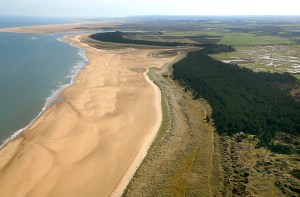 Dramatic coastal erosion along huge sections of the Norfolk shoreline is threatening homes and livelihoods – but also exposing thrilling, new archaeological finds. This part of the world, now known as the Deep History Coast, is home to the earliest traces of human life. In 2013, a storm at Happisburgh exposed 850,000-year-old human footprints, the oldest found outside Africa.
Dramatic coastal erosion along huge sections of the Norfolk shoreline is threatening homes and livelihoods – but also exposing thrilling, new archaeological finds. This part of the world, now known as the Deep History Coast, is home to the earliest traces of human life. In 2013, a storm at Happisburgh exposed 850,000-year-old human footprints, the oldest found outside Africa.
Meanwhile, beach erosion at Holme also revealed Seahenge, a mysterious Bronze-age circle of oaks and at West Runton the UK’s biggest pre-ice age mammoth remains were discovered.
Apart from the fossil-hunting, the star attraction, however, is the exhilarating combination of big skies and vast sandy beaches on the north Norfolk coast. As the tide retreats, it leaves miles of endless sand, mudflats and twisting creeks – and often a long walk to find the shoreline.
One of the biggest treks to reach the sea at low tide is found at Holkham. Part of the Holkham Estate, the 18th century Palladian hall and its nearby beach are accustomed to visiting Hollywood stars, including Gwyneth Paltrow and Keira Knightley. It’s a popular movie location and Shakespeare in Love was filmed here. Yet, despite its celebrity status Holkham beach never feels crowded, even at peak season.
Much of this stretch of coastline is an Area of Outstanding Natural Beauty. It’s a haven for rare birds and wildflowers and you can also witness one of Britain’s great wildlife spectacles – seal breeding season. The endless flat sand, shallow waters and protective, high dunes provide an ideal location for seals to have their young between June and August.
The beach at Horsey and the four-mile shingle spit at Blakeney Point are the best places to see the seals, ideally on a boat trip from Blakeney Harbour or Morston Quay. The Blakeney colony of Common and Grey seals is thought to be the biggest in England.
Make sure you leave enough time to sample the local seafood. One of the best is the Blakeney Crab Shed which sells crabs, lobsters, oysters, mussels and samphire. This dainty sea vegetable looks a little like asparagus and has a distinctively salty, crisp flavour. It grows abundantly on the north Norfolk salt marshes and it’s a local delicacy that anybody can find and pick with enough patience and luck.
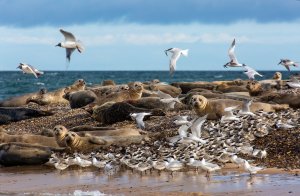
Blakeney Point is also notable for its spectacular displays of the summer-breeding tern colony. Further along, at the RSPB Titchwell Marsh Nature Reserve, reedbeds, saltmarsh and fresh-water lagoons attracts avocets and the elusive bittern, with its call booming from deep in the reedbeds.
This part of Norfolk, where the sea is fringed by muddy tidal creeks and endless salt marshes, is a favourite with affluent weekend visitors. The sailing crowd livens up the restaurants and bars in the genteel villages of Brancaster Staithe, Burnham Overy and Stiffkey.
Admiral Horatio Nelson spent his childhood here and learned to sail at Burnham before joining the navy. The local pub is named The Hero in his honour. The staithe is also the point of departure for a boat trip to the isolated Scolt Head Island nature reserve, a breeding ground for sandwich and little terns.
Further south, the harbour town of Wells-Next-the-Sea attracts the biggest crowds. One of the great Tudor ports of east England, it’s home to the famous French’s fish and chips, crabbers dangling lines over the quayside and the harbour-wall walk that are the main attractions here now.
A little further along the sea moves closer to the shore and the waves eat away at the battered cliffs. This is Poppyland – a more traditional seaside offering anchored by the towns of Cromer and Sheringham.
Cromer is world-famous for its delicious crab. The chalk shelf and nutrient rich waters make it uniquely tender and flavoursome with a high proportion of white meat. Stalls and cafes along the narrow-streets sell it freshly dressed in its shell – just add a dash of lemon and black pepper.
With its pier, elegant promenade and Hotel de Paris, Cromer is the quintessentially Victorian seaside town. Surprisingly, it also now a surfing hotspot. North-facing, with sandbanks near the pier, it creates good waves with lessons on offer from qualified instructors at The Glide Surf School.
From here the road heads to east Norfolk and the traditional bucket-and-spade resort of Great Yarmouth. With each mile, the fine dining restaurants and sailing crowd thin out and the amusement arcades and candy-floss stalls ramp up.
It’s wild and windy and coastal erosion bites hard along here, with chunks of Happisburgh, Winterton and Hemsby continually reclaimed by the sea.
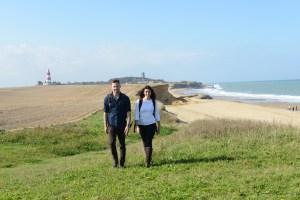
Away from the tourist hotspots, you can discover some amazing secret beaches, such as Cart Gap and Waxham. This is where the locals head for a day out.
Nearby Breydon Water and Burgh Castle Roman Fort are also a quieter place to enjoy a stroll and take in the reed-choked marshes and huge skies.
Meanwhile, Great Yarmouth is packed with visitors enjoying the famous Pleasure Beach, a nine-acre amusement park on the seafront as well as the town’s two piers and celebrated miles of golden sands.
The small village of Hemsby and its bigger cousins Gorleston and Great Yarmouth, provide a similar vibe of endless golden sands, traditional bucket and spade British seaside complete with saucy postcards, a cone of chips and amusement rides.
On a blustery day, it doesn’t get much better than parking up on Gorleston clifftop and watching the waves crash against the beach and pier.
TEN HIDDEN GEMS ON THE NORFOLK COAST
- Waxham Beach. Firmly off the beaten track. Hidden behind trees and sand dunes, there’s no official cark park or amenities – making this a haven for a quiet walk.
- Tourists head straight for Cromer or Sheringham, but those in the know enjoy a day out at the less showy Overstrand – especially if they have a dog. With plenty of walks and a café that even sells homemade ‘doggie burgers’.
- The Poppy Line. A scenic, heritage steam and diesel railway journey with amazing views of the coast. From Sheringham along the coast to Weybourne and through the heathland to Holt.
- East Ruston Vicarage Garden. This garden is simply magical, a verdant, sheltered garden with themed areas such as the Dessert garden, connected by avenues with intentional views out to landmarks such as the nearby lighthouse.
- Cart Gap beach. Set between the better known Sea Palling and Happisburgh with its famous red and white lighthouse, this beach is off the beaten track. A narrow, single-track lane leads down to a sandy beach where you can have a peaceful stroll. Stop off at nearby Smallsticks Cafe for tea and cake after.
- Kelling Heath. Acres of rare open heath and woodland scattered with hidden viewing points out to sea that take your breath away and that only the locals know about.
- Merrivale Model Village, Great Yarmouth. Quirky and kitsch, this model village has been here for decades. Some of the displays might be a bit dated, and sometimes a bit tired, but it’s certainly fun.
- Peter Scott Walk. Explore The Wash, one of England’s last great coastal wildernesses and one of the most important wetland site in the UK. Peter Scott, only son of Antarctic explorer Captain Scott, lived in this area in the 1930s. The walk in his name follows the old sea bank along the edge of the wash to a point on the west side of the River Ouse in Kings Lynn.
- West Runton. One of the best places in East England to hunt for fossils in the cliffs. An ice-age Steppe Mammoth was discovered here in 1990 (lots of info at nearby Cromer Museum). Rock pools are a favourite with kids and it’s great for dog walking too.
- Time and Tide Museum, Great Yarmouth. A gem of a museum set in one of the UK’s best preserved Victorian herring curing works. Tells the story of Great Yarmouth, once the centre of the herring industry.
WHERE TO EAT
- Rocky Bottoms. West Runton. Fresh seafood in a great location overlooking the sea.
- French’s Fish and Chips. Wells-next-the-sea. Worth queuing for. Eat looking out to sea on the harbour wall.
- Rocket House Café. Cromer. Locally caught lobster and classic fish and chips in a light-filled café with a sea-view balcony.
- Dune’s Café. Waxham Barn. Set in a historic old barn, just a short walk from Horsey Beach.
- Old Town Beach Café. Hunstanton. On the track down to Old Hunstanton Beach. A popular, busy stop off for beach walkers.
WHERE TO STAY
- Morston Hall -17th century hotel and Michelin-starred restaurant run by Galton Blackiston.
- The White Horse, Brancaster Staithe – Hard to beat location that backs onto the marshes, lagoons and creaks of the North Norfolk coast.
- The Hoste Arms, Burnham Market – Comfortable and stylish hotel on the village green.
- Cley Windmill – Brilliantly restored, now a B&B on the edge of the marshes.
- The Cliftonville, Cromer – A revamped Edwardian hotel on Cromer clifftops.
THE SUFFOLK COAST
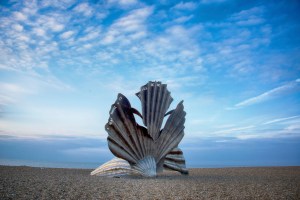
Unlike the unbroken sweep of the north Norfolk seashore with its salt marshes and mudflats, the Suffolk coast is punctuated by wide estuaries deep enough for yachts, fishing boats and even cargo ships.
Just a two-hour drive from London, visitors are attracted by the hiking, camping, bird-watching and nature reserves on this wild coastline where salt and freshwater marshes back onto remote beaches.
Art and music-lovers will find plenty here too, most notably a music festival founded by composer Benjamin Britten, the striking Maggi Hambling Scallop sculpture on pebbly Aldeburgh beach and music-festival Latitude at Henham Park, near Southwold.
But the main appeal of the Suffolk coast is its genteel town resorts. These days they are arguably a touch gentrified, but with this comes some incredible places to eat, stay and enjoy culture and art.
There are few greater British seaside pleasures than a stroll to the end of Southwold’s quirky pier followed by a fish and chip supper and a pint of the town’s famed Adnams Ghost Ship ale.
Built in the Victorian era as a landing stage for steamships transporting tourists from London, the pier extends 623 feet into the North Sea. As well as the iconic view back to the town’s beach-hut lined promenade and lighthouse, it’s notable these days for its eccentric Under the Pier show.
A re-invention of the amusement arcade designed by cartoonist and engineer Tim Hunkin, this genius attraction allows you to take out your frustrations with the financial industry on the Whack A Banker machine or experience an insect’s view when you step on the Fly Drive.
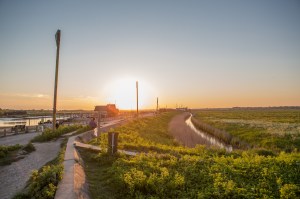
Declaring itself ‘the jewel of Suffolk’s Heritage Coast’, Southwold is almost an island, bounded by the North Sea and the River Blyth. It was a favourite with affluent visitors during its Victorian heyday – and most definitely still is.
Expensive, independent shops and eateries abound along the high street. Enjoy a ‘char-grilled Suffolk venison haunch steak at The Crown or impulse-buy a £1,225 Mulberry Bayswater handbag at designer clothing store Collen and Clare.
If shopping is not for you, head down to Southwold harbour instead where you can enjoy the blustery sea air and incredible view for free. Those-in-the know always stop off at Sole Bay Fish Company who sell their daily catch here, either to take home or as a fresh-platter in their dog-friendly restaurant.
On the south side of the River Blyth, accessed via a row-boat ferry ride or footbridge, is the Georgian village of Walberswick – the self-appointed capital of crabbing, which hosts the British championships.
The picture-postcard village, with its long sand and shingle beach backed by grassy dunes and acres of marsh and heathland, has long been a favourite with celebrities. Look closely and you might spot film director Richard Curtis and his wife Emma Freud sitting in one of the snugs at The Bell, on Walberswick Green.
If you prefer a less gentrified experience, the traditional resort towns of Lowestoft and Felixstowe are more down to earth. A little past their Victorian and Edwardian heyday when their pleasure piers and boating lakes were the height of fashion, these two relatively large coastal towns still have much to offer as a family, seaside destination.
The arrival of a rail line in 19th-century Lowestoft established the town as a major east coast port and enticed holidaymakers. The swimming is still good here, with the beach south of Claremont Pier designated with a Blue Flag.
Hidden behind an industrial estate, Ness Point, in north Lowestoft, marks the most easterly point of the British Isles. It merits a visit, if only as a rather isolated and bleak oddity. This important site sits on the concrete sea wall behind the Bird’s Eye frozen food factory and is marked with a modest plaque showing direction and distance to the likes of Zagreb 788 miles or Rotterdam 122.
It’s also extremely windy here, which explains why this part of the world is also the centre of the UK’s renewable energy sector with the UK’s largest wind turbine, 126 metres high, known locally as Gulliver, just by Ness Point.
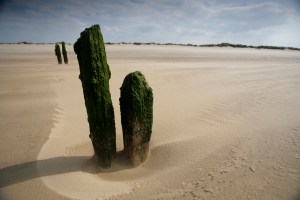
Meanwhile, nestled between the rivers Orwell and Deben, Felixstowe is the only seaside resort in East Anglia to face southwards. Most know it as a ferry terminal but it’s much more than this. Away from the docks, there is a popular seaside resort with its regenerated Seafront Gardens, beach huts and four miles of sand and shingle beach.
South of the town you can enjoy coffee and cake at View Point Cafe. From here you can watch the huge container port or explore the area’s military and maritime history at Landguard Fort. This was the site of the last opposed seaborne invasion of England in 1667 and the first land battle of the Royal Marines.
The area between the main coastal resorts in Suffolk also repays a visit with its isolated fishing villages and vast areas of nature reserve countryside backing on to quiet, isolated beaches. This is where you can discover the east coast of England at its most wild and untouched.
Head to Shingle Street if remote coastal villages is your thing – because this is about as inaccessible as it gets in East Anglia. The beach faces the ten-mile-long shingle spit of Orford Ness and Terns lay eggs nestled in the shingle and seals bask at the estuary entrance. On blustery days the wind whips up the sea and waves crash onto the shingle beach.
It’s peak birdwatching territory all along the coast and especially at RSPB reserves at Dunwich and Minsmere. The shingle vegetation, grasslands, lowland heath and reedbeds attract the Avocent, Bearded Tit, Bittern, Marsh Harrier and Nightingale. This is where you can sample a quieter side of the Suffolk coast – a remedy for the stresses of life that doesn’t disappoint.
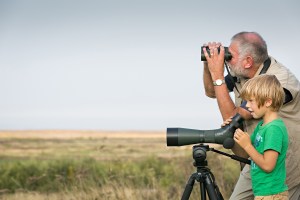
TEN HIDDEN GEMS ON THE SUFFOLK COAST
- A quirky village originally built as a holiday camp in 1922. It has an artificial lake and ‘the house in the clouds’ an unusual water tower with a boarded house on top, available to hire as a holiday home.
- Sailors’ Reading Room. Built in 1864 as a refuge for mariners, you can grab your favourite book and take time out in these historic surroundings.
- Felixstowe Ferry. A tiny village with a great view across the River Deben estuary. Fishermen’s cottages, Martello towers, boat sheds and ferries across the river to Bawdsey Quay during the summer season.
- Snape Maltings. An arts complex on the banks of the River Alde in an area of Outstanding Natural Beauty. Best known for its concert hall which hosts the world famous Aldeburgh Festival, founded by composer Benjamin Britten. Independent shops, art galleries, pub and cafes.
- Once a thriving medieval port now a nature reserve. Storm surges and coastal erosion washed the urban centre away and rumour has it you can hear the bells of the lost church ringing from below the waves. Explore its past at the Dunwich Museum.
- Orford Castle. Orford was once an important port and still has its medieval castle which overlooks the attractive village. Hundreds of steps, so you need to be fit. Built by Henry II in the 12th Incredible views over Orford Ness, a long, wide shingle spit at the mouth of the River Ore and a former Ministry of Defence radar station. (See our feature on Orford Ness in this month’s issue on page 37)
- Adnams Brewery Tour, Southwold. One of the most modern breweries in the UK with a long tradition. Follow the process from grain to glass – and finish with a taste test.
- Covehithe Beach. Not many people know about this isolated beach set at the end of a lane. A peaceful stretch of sand backed by crumbling cliffs. Park by the church and follow the footpath through the summer barley fields to the dunes and a beautiful beach.
- Bawdsey Radar Museum. An unexpectedly fascinating small museum and the site of the first operational radar stations in the 1930s. Looks at the development of radar and its use in the Second World War.
- The Sailor’s Path. A waymarked walking route through the Suffolk Coast and Heath Area of Outstanding Natural Beauty. Extends from the Stour estuary in the south to Kessingland. The highlight is the section between Snape Maltings and Aldeburgh.
WHERE TO EAT
- Adnams Brewery. Southwold. Great food and beer brewed on-site.
- The Walberswick Bell. Enjoy a pub lunch after a blustery walk on the beach.
- Butley-Orford Oysterage. Market Hill, Orford. Simple, uncomplicated and delicious seafood.
- Aldeburgh Fish and Chips. High Street. Always a queue, but it’s worth the wait.
- Harris and James Ice Cream Parlour. Southwold. Handmade and delicious, classic flavours or more obscure bubble gum. There’s even a meaty version for your dog.
WHERE TO STAY
- The Ship, Dunwich – Cosy, boutique pub with overnight accommodation.
- The Swan Hotel, Southwold – An impressive and luxury Georgian hotel in the heart of this genteel resort.
- Wentworth Hotel, Aldeburgh – An Edwardian half-timber seafront hotel. Elegant public areas that look out on the beach.
- The Crown & Castle, Orford – Rooms and a restaurant on the main square.
- Seckford Hall – A luxury hotel and spa. Ideal base for exploring the more remote Suffolk heritage coast between Aldeburgh and Felixstowe.
Heading to the Norfolk coastline this Summer? Check out our pick of the 10 Best Places to Eat on the Norfolk Coast.

